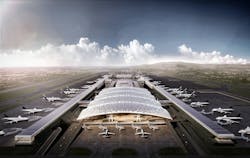Passengers at the Forefront of Air Travel
Whether boarding a business flight or embarking on a space odyssey, it is clear that significant advances in air travel will result in increased passenger traffic—a number expected to exceed six billion by 2030, according to Arup.
Designing amenities for the airport of the future may not look like the spaceport cantina from classic Star Wars, but integrating technology and infrastructure will be key to accommodating a personalized passenger experience for an expanding and diverse body of travelers, says Arup’s leader of Global Aviation, Susan Baer. For instance, JFK International Airport Terminal 4 just announced an indoor dog relief area as a convenience to those traveling with pets and service animals. “We recognize the growing presence of animals in our terminal and the significant increase in passengers traveling with pets, and we wanted to provide owners with a convenient location to relieve their animals without having to exit the terminal,” president and CEO of JFKIAT Gert-Jan de Graaff, told Airport Revenue News. The FAA will soon require all major airports to include this amenity.
To understand how today’s airports will respond to security, sustainability and infrastructure implications of this increased demand, Arup’s comprehensive study gathered a multi-industry group to brainstorm implicit solutions to the main components of the passenger experience at the terminal, baggage check/claim, and security checkpoint(s). They concluded that by applying the present-day logistics capabilities of online retail fulfillment would transform air travel into a more efficient experience. Airports are framing expansion with a more multi-modal mindset, says Baer; it’s a way to increase volume without the high costs associated with expanding the physical terminal. High-speed moving walkways requiring minimal infrastructure updates will shuttle people three times faster than conventional people movers. Los Angeles is exploring an airport people mover to connect to its rail lines, reports Baer. “It’s to handle the growth; but the fact that it’s more environmentally sustainable, reliable and predictable makes it a better journey for customers.” It also contributes to employees’ commutes, providing a reliable stable workforce critical to fully functional airports. Airlines are purchasing small to mid-sized planes, “if you look at the order book from the last couple air shows, there is less interest in larger aircraft than there was a few years ago,” observes Baer. Smaller aircraft benefit both passengers and airlines by increasing the speed of boarding and deplaning, and maximizing the use of aircraft—keeping them on the ground less and in the air more.
Arup’s “Future of Air Travel” report gets people thinking about how might you plan a terminal opening in five years, or be in a terminal 10 years from now, and how to include those possibilities,” says Baer. Future of Air Travel The travel experience will be more personalized, from beginning to end. By harnessing personal data, the smart airport of the future will be able to respond to the passenger’s needs at every stage of the journey. Terminals will be planned and designed more efficiently, as processing functions are increasingly integrated into the Smart City grid. Passenger screening will be streamlined. Currently focused on gauging the capability to do harm, airport security stations consume substantial floor space and resources to screen for prohibited items. Risk-based screening, which assesses an individual’s intent to harm, offers the promise of reducing the need for traditional checkpoints through virtual, data-based screening. The passenger terminal will be more dynamic and efficient. By consolidating functions such as flight check-in, customs and screening, the layout of passenger terminals can be condensed into more operationally flexible footprints, eliminating extended, multi-stop treks from ticketing counter to departure gate. Checked bags will travel on their own. Smart-suitcase technology will free travelers from hauling luggage to and through airports. From a remote drop-off location, bags will be automatically routed to destinations, reducing on-site airport baggage handling systems.
